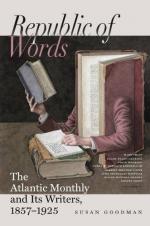As the reader thrust the terror of these words upon us, all started back, for the curtain was plucked suddenly away, and there before us, not in Clarian’s picture, it seemed, but in very truth, stood Macbeth, conscious of the murdered presence. Even the reader, absorbed as he was in his text, paused short, amazed; and I forgot that I had seen this picture, only knew that it was a living scene of terror. Doubtless much of this startling effect was the result of association, the agitation of anxiety, the influence of the impressive text, the suddenness of the apparition, the unusual light; but in the figure of Macbeth, at which alone we gazed, there was a life, a terrible significance, that outran all these causes. It was not in the posture, grand as that was,—not in the sin-stamped brow, rough with wrinkles like a storm-chafed sea,—not in the wiry hair, gray and half rising in haggard locks, like adders that in vain try to escape the foot that treads them down,—nor in the mouth, for that was hid behind the impotent guard of the upraised arm and clenched fist,—but in those painted eyes, into which, all-fascinated, we ever gazed, reading in them all that crouching terror, all the punishment of that spectral presence, all the poignant consciousness of his fate to whom such things could happen, to whom already his victims rise again,
“With twenty mortal murders on their crowns
And push us from our
stools!”
While I yet gazed, a sickening terror pervading me in the presence of these ghastly eyes, there came a voice, as if from afar,—“Read on!”—so consonant with the tone of my emotions, that I looked to see the figure itself take speech, until Mac, with a gasp, resumed. Still, as he read, the nightmare-spell possessed me, till a convulsive clutch upon my arm roused me, and instinctively, with the returning sense, I turned to Clarian.
Not too soon,—for then, in his own person, and in that strange glare, he was interpreting the picture to us. He stood, not thrown back like Macbeth, but drawn forward, on tiptoe, with neck reached out, form erect, but lax, one arm extended, and one long diaphanous finger pointing over our heads at something he saw behind us, but towards which, in the extremity of our terror, we dared not turn our eyes. He saw it,—more than saw it,—we knew, as we noted the scream swelling in his throat, yet dying away into an inarticulate breath ere it passed the blue and shaken lips,—he saw it, and those eyes of his, large enough in their wont, waxed larger still, wilder, madder with desperate affright, till every one of us, save the absorbed reader, recognized in them the nightmare horror of the picture,—knew that in Macbeth Clarian had drawn his own portrait! There he stood, drawn on, staring, pointing—
“Stop!” shouted Dr. Thorne, his voice hoarse and strident with emotion; but Mac, absorbed in his text, still read, flinging a fine and subtile emotion of scorn into the words,—




